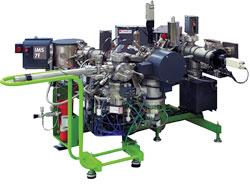|
Instrument Database:
CAMECA SAS - IMS 7f / 7f-GEO
| |
|

|
| |
|
| |
|
| Year of introduction |
|
| Status |
available |
| Company |
CAMECA SAS
|
| Categories |
Mass spectrometer: SIMS/SNMS
|
The CAMECA IMS 7f is a magnetic sector SIMS with top performances in depth profiling and secondary ion microscopy.
Its unique stigmatic optical system allows both direct ion microscopy and scanning microprobe mode.
The High Mass Resolution capability permits true elemental analysis by eliminating the numerous interfering ions (56Fe/28Si2, 31P/30SiH, 32S/16O2...). The HMR capability ensures the instrument's long life, especially in fields (semiconductors) where materials and thus analytical problems (i.e., mass interferences) change rapidly.
The magnetic sector analyzer allows to work with a high DC extraction field; accordingly, analyzer transmission is higher by two orders of magnitude than with quadrupole analyzers. High transmission is absolutely necessary for performing analyses or profiles on small areas (ex: 100 µm test pads in semiconductor, or µm size particle analysis), while maintaining excellent detection limits (down to the ppb level).
High Mass Resolution, High Transmission and Stigmatic Optics allow the CAMECA IMS 7f to show benchmark results and application together with the highest sample throughput (sputter rates up to µm/min).
The IMS 7f-GEO is a version specialized for high precision/ high throughput measurements (reproducibility in the 1E-4 range, EM and dual FC, fast peak switching, dedicated softwares) in geological samples: REE elements, stable isotopes (H, C, O, S...) and geochronology.
Compared to previous CAMECA IMS instruments, the IMS 7f offers:
Dramatic improvements for shallow profiles: the impact energy can be reduced to very low level (300 eV), with independent control of the impact angle by the continuous variation of extraction voltage and primary energy. High speed of erosion (2 nm/min with 500 eV O2+, 45° on silicon) can be maintained at low energy with the new accel/decel optics for the duoplasmatron. A high sensitivity is now maintained at low energy even for heavy ions (cesium clusters, noble metals...) thanks to the new electron multiplier post-acceleration.
A new eucentric rotating stage reduces rugosity even on profiles from small dimension crater, at any position on the sample holder.
An important new feature of the IMS 7f is its automation system, which increases the analysis throughput by allowing unattended, chained operation. Analyses can be run in a completely automatic mode with an excellent repeatability over hours and days. In addition, all aperture and slit movement are now motorized and computer controlled in standard. This ensures best reproducibility and allows an easier use of the instrument through memorized settings and recipes.
Ultra High Vacuum is obtained thanks to a combination of Titanium sublimation with ion or turbo-molecular pumping. UHV technology ensures excellent detection limits for light elements (H, N, C, O, ...) and becomes an important point for ultra-shallow profiling when the sputter rate is reduced at low energy.
The improved IMS 7f electron flood gun provides a unique self-compensation mode that makes it possible to measure depth profiles on complex insulating structures and isotope ratios in minerals with an accuracy at the permil level.
|
|